General Metal and Holloware
 |
Richard Perry, Sons & Co
Edward Perry
Temple Street |
 |
Much of the account below is taken from W. H. Jones's "The
Story of Japan, Tin-Plate Working and Bicycle and Galvanising Trades in
Wolverhampton", 1900. Further information has been supplied by
Iris Bean, whose great great grandfather was William Perry, Richard's
brother and Edward's uncle.
Unfortunately Jones is not at all strong on dates.
According to Jones, these two firms of japanners and tin plate workers
were started at about the beginning of the 19th century, one by Richard
Perry and his son, George; and one by his other son, Edward. It
seems that Edward Perry became much the larger firm but it eventually
came to be part of Richard Perry's firm.
Edward Perry
Jones says that "Edward Perry was of medium height, a thin
wirey man, with a fidgety manner and of a restless disposition. He
had dark piecing eyes and an incisive way of speaking".
|
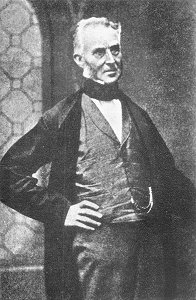 Edward Perry (photo from the History
of the Chamber of Commerce)
Edward Perry (photo from the History
of the Chamber of Commerce) |
Perry was a self-made man. He attended Wolverhampton
Grammar School (and later in life became one of its trustees). He
started work as a japanner at the Old Hall works in Wolverhampton and
then started his own small firm in Queen Street. As Jones has it:
"by dint of hard work, pluck, perseverance and good common sense, he
built up the business". He moved to much larger premises in Paul
Street.
When the workers in these trades decided to produce a rate
book and impose it on the employers, Loveridge and others accepted it
but Perry was one of those who refused, arguing that the rates were
based on hand work and could not possibly apply to his highly mechanised
works.
The strike was long and bitter, with Perry resorting to
importing foreign labour from France and Germany and eventually
prosecuting the strike leaders and having them imprisoned. He
won.
|
|
Perry then entered local politics and was elected Mayor in
1855, during which time he, with considerable courage and determination,
settled a dispute about the waterworks which had brought local
government in Wolverhampton to a farcical, bankrupt halt. He was
re-elected for another year.
Perry took the initiative in forming the Wolverhampton
Chamber of Commerce, calling its inaugural meeting at the Town Hall on
the 12th March 1856. He was elected its President on 9th May 1856
and remained its President for its first eight years. He was also
a shareholder in the Mechanics Institute in Queen Street.
Jones says: "It was said of him that he never shrank from
discharging any public duty. Not possessed, as he said, of
extraordinary talent, yet by plodding industry and business capacity,
combined with honesty of purpose, he rose by his own exertions and
successfully conducted a large manufacturing concern."
He built himself a large house, Danescourt in
Tettenhall. This house was designed by Joseph Hanson (of London
cab and Birmingham Town Hall fame). But as soon as it was
finished, Perry died. His burial (and that of his brother,
Richard) is recorded in the registers of St. Michael's, Tettenhall but
neither his grave nor Richard's can now be found.
Edward Perry had no children to carry on the business
after his death. Jones concludes: "His trade, after his
death, was transferred to his nephews, Messrs. Lees, who at that period
were carrying on the business of Richard Perry & Sons, in Temple Street.
At the present time [sc.1899] the same concern is being carried on by
William Lees, under the title Richard Perry, Sons and Co.". The
Jeddo works themselves were sold to John Marston, a former apprentice,
eventually becoming part of the Sunbeam works.
Note: Edward Perry had a brother William, who seems
also to have been a japanner. William had three sons: Henry
(whose trade is not known); Edward (who was also a japanner in
Wolverhampton but who later moved to Manchester as an artist); and
Theodore (also a japanner; his son Charles was a tin plate worker).
Richard Perry, Sons and Co.
This company, set up by Richard Perry and his son George,
was in Brickkiln Street. Father and son had both been japanners in
the Old Hall works and struck out on their own. Jones gives no
further information about this firm until we find his reference to
Edward Perry's nephews, the Lees Brothers, carrying on the firm of
Richard Perry & Sons. On Edward Perry's death they acquired his
business, possibly by inheritance. It was, almost certainly, a
much larger concern. It therefore seems that the company known as
Richard Perry, Sons & Co, was a direct continuation of Richard Perry and
George Perry's firm and incorporated Edward Perry's business.
|
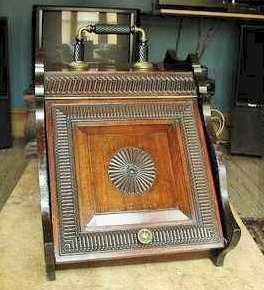 |
|
 A coal box in wood and brass and the maker's
plate from it.
Thanks to A. Tozer for the photos. |
Richard Perry, Son & Co has some current fame as it is one of
the few companies which has been positively identified as having
engaged the services of Dr. Christopher Dresser, though exactly
what that prolific Victorian industrial designer was engaged to
do is not known. This firm was one of those which, at that
time, marked at least some of its wares. Such marked
pieces are now rare and, on the grounds of a possible connection
with Dresser, tend to be expensive. But they can be used
to give some idea of what sorts of goods Perry's were producing.
|
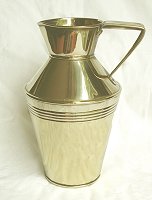 |
This jug, by Richard Perry, is typical
of the kind of design to which the name Dresser is
almost automatically applied. In fact it could
have been designed by any tinsmith. It consists of
three frustra of a cone - the simplest shape to make
from sheet metal. The handle, with the "typically
Dresser" handle is also as simple as can be.
Straight lines are easier, and cheaper, than curves. |
|
| Two water cans, one showing the pattern of
roundels which seem to occur frequently on Perry peices.
Angeline Johnson suggests that, if there is a design reference
here, it is an arts and crafts medieval reference, to heraldic
roundels, shield bosses or door nails. |
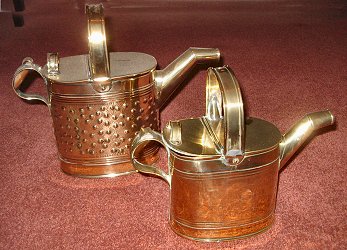 |
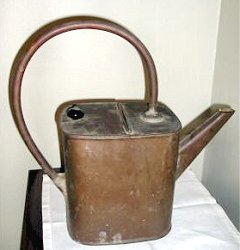 |
A water can, quite unlike the oval bodied type
produced by Perry and all the other manufacturers; and
with a handle that is Dresseresque and was used by Loveridge and
others long before Dresser.
Thanks to Ken Cummings, of
Greensboro, NC, USA, for the photo. |
| Two half covered coal scuttles, one with the
roundel pattern and the other with a scale like pattern. |
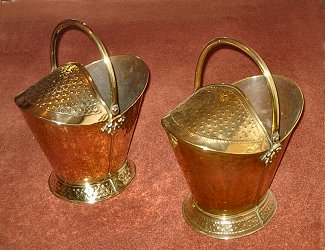 |
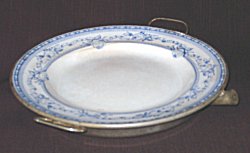 |
Perry's, like all the other brass and copper
ware makers, were general tin plate workers, probably before,
during and after the time they were turning out brass and copper
wares. This is a hot water plate by Perry's. |
|
This photograph of a Perry hot water
plate was kindly sent by Andre' Janssen.
|
 |
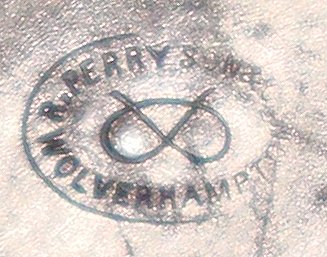 |
The maker's name on the bottom of Andre' Janssen's
hot water plate. |
'Kordofan'
chamber-stick, which was made by Perry in conjunction
with Christopher Dresser.
It was produced in brass, or tinplate, and
enamelled in the fashionable colours of the period. This
example, unusually, is in the original finish.
He also has another example, with no Dresser label,
that was produced by Griffith and Browett Limited, of
Birmingham.
|
 |
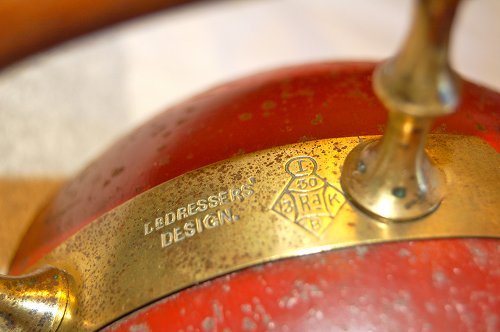 |
A close-up view of the maker's mark. |
|

|
|
Return to the
list of
companies |
|